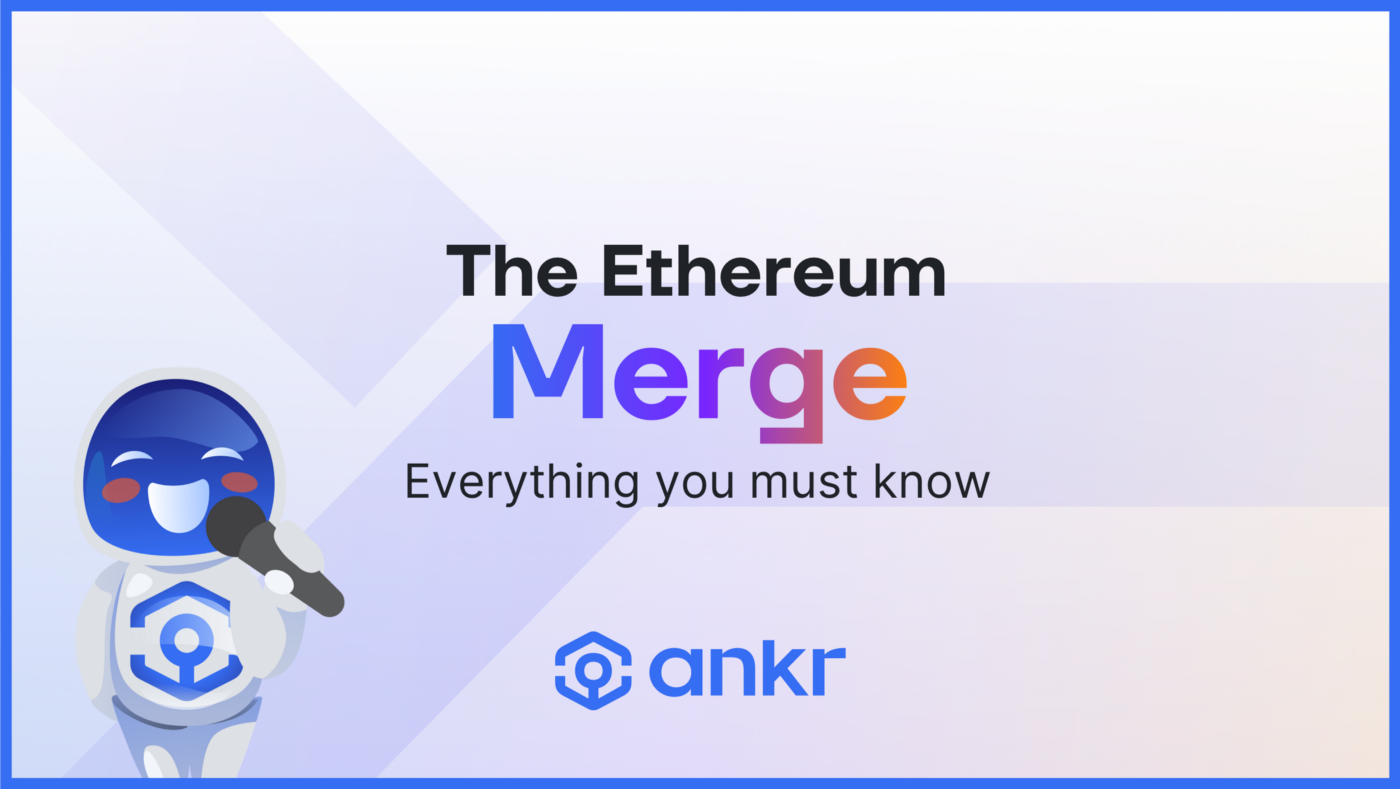The Ethereum Merge: Everything You Must Know
October 28, 2022
12 min read

The phrase 'Merge' has sparked the imagination of many in the crypto world for quite some time. The Ethereum Merge has been on the minds of key individuals in the cryptocurrency industry, and many have shared their views and perspectives on one of the most meaningful actions in the brief history of blockchain technology.
What Is The Ethereum Merge, Exactly?
On September 14th, 2022, the Ethereum blockchain's consensus technique will change from proof-of-work (PoW) to proof-of-stake (PoS) (PoS). Vitalik Buterin, Ethereum's creator, discussed this upgrade in public blogs during Ethereum's initial coin offering (ICO) in 2014, long before the network's launch in July 2015. Although Ethereum has successfully overcome numerous testing challenges since then, periodic delays have dampened excitement. The upgrade's testnet went live in early May 2019, and the new 2.0 chain started functioning in parallel in December 2020.
Validators "stake" the blockchain network's native coin by putting it into a private smart contract. Then, validators are selected randomly to validate each new block and earn the delegated payment.
The Merge from ETH 2.0
The Merge is part of what was formerly known as "ETH 2.0," a set of enhancements that rebuild the blockchain's essential characteristics. It is also regarded as the second step of Ethereum's multi-part upgrade to increase scalability, security, and energy efficiency. It will do this via sharding and rolling out upgrades to boost scalability.
Ethereum has been actively improving since late 2020 when a testing version of the Ethereum PoS blockchain known as the Beacon Chain was launched. Because ETH2 is the next version of Ethereum, the transition from ETH PoW to ETH PoS has been dubbed "The Combine." During The Merge, the PoW chain and the Beacon Chain will merge to form a single blockchain.
The PoS consensus technique is more environmentally friendly than the PoW consensus mechanism, in which miners compete for new blocks by squandering massive amounts of computer power and energy. Aside from the environmental impact, many believe that switching to PoS would reduce the risk of over-centralization by making the validator function available to everyone with Ether to stake rather than simply those with expensive mining equipment.
What Will Change After the Merge?
More individuals and firms who aren't currently involved in the cryptocurrency sector, particularly institutional investors, will be able to join the Ethereum market. DeFi protocols, NFTs, and the Web3 ecosystem are now available to millions (if not billions) of consumers. This is almost probably positive news for the Ether price.
It will change Ethereum and make it the industry's premier Proof-of-Stake (PoS) blockchain, but not without a protracted and expensive development phase.
In this section, we will look at some of The Merge's possible implications and the on-chain indicators that observers may use to track these effects.
How Does Staking Keep the Network Safe? And why is it so pricey? Billions of dollars are being invested in securing, stabilizing, and scaling the Ethereum PoS network. So far, the total amount of Ether invested has surpassed 13 million ETH. In other words, before the Merge, users (also known as Validators) staked their Ethereum and committed almost $29 billion to the network's security.
The Validators' reward may not seem enticing right now, but it will increase from 4% to 10% in the near future. The amount of Ethereum staked surpassed Solana's market value, the most extensive PoS network at the moment. However, not all validators are decentralized since some are controlled by centralized exchanges, custodians, and staking pools like Lido and Rocket.
However, validators should be aware of technical concerns with such a significant shift. For inappropriate conduct, a Validator's stake may be reduced. Validators, for example, may face repercussions for dishonesty. They may also be ejected from the network owing to slashable infractions such as duplicate proposals, competing proposals, multiple voting, and downtime (offline penalty when more than 1/3 of the nodes are unavailable).
The Ascension of Ultrasound Money
The elimination of miners from the Ethereum ecosystem is also something to think about since the need to pay large block rewards will no longer be an issue, significantly limiting the generation of new ETH. User payments are partially burnt and partially allocated to validators throughout the process. This is the Ether burn strategy employed in the EIP 1559 London hard fork, which burned over 2.25 million ETH, or more than $5.6 billion.
It will lower inflation from 4% to -1%, making Ether deflationary anywhere network activity increases. This gives rise to the phrase "Ultrasound money," which some community members have already dubbed Ethereum.
To address scalability concerns, the original design called for sharding procedures to be carried out prior to The Merge. However, with the emergence of layer 2 scaling solutions, the emphasis has changed from proof-of-work to proof-of-stake through The Merge.
Sharding tactics are constantly evolving. However, this may no longer be required if layer 2 technologies become increasingly prevalent for expanding transaction processing. Today, sharding strategies are mainly concerned with equitably distributing the burden of storing compressed call data from rollup contracts. Proof-of-stake implementation is required for exponentially rising network capacity.
What About the Myths of the Ethereum Merge?
Not everything you read or hear about the merger is accurate. Here are a few prevalent beliefs that have been disproved.
"Node operation requires the staking of 32 ETH" This is not true. Who may sync their own verified copy of Ethereum is unrestricted (i.e., run a node).
"Gas costs will be much lower following the merge" is likewise false. The Merge is a change in the consensus technique, not an increase in network capacity, and it will not result in lower gas costs.
"Transactions will be much faster after The Merge" is likewise inaccurate. Despite modest changes, the transaction speed on layer 1 will remain constant.
"After The Merge, you may withdraw staked ETH" This remains wrong. The Merge does not yet support staking withdrawals. Withdrawals from staking will be allowed in the next Shanghai upgrade.
"Until the Shanghai update, validators will not be rewarded with ETH when withdrawals are allowed" False. Fee tips/MEV will be credited to a validator-controlled Mainnet account and made promptly available.
"When withdrawals are permitted, all stakers will go at once" This is also inaccurate. For security concerns, validator departures are rate restricted.
"The staked APR will grow thrice after The Merge" False. Recent projections predict a 50% increase in APR after the Merge rather than a 200% increase.
"The Merge will disrupt the chain" This is incorrect. The Merge upgrade is designed to facilitate a smooth transition to proof-of-stake.
Staking and Ethereum Network Upgrades in the Future
One of the first questions is whether The Merge will enhance staking activity on the Ethereum network.
More than $30 billion in Ether has been staked on the PoS Beacon Chain, making it the most valuable PoS blockchain even before it replaces the Ethereum PoW Network. Staking requires installing specific software and hardware, which may be obtained from third parties. Many other people have staked by contributing ETH to a staking pool. Staking pools, like mining pools, allow several users to combine their resources in order to boost their chances of being chosen to propose a new block and split the profits.
For various reasons, staking will become an even more enticing choice after The Merge. Users will likely feel more at ease staking once PoS is fully introduced and PoW is banished to the past. The notion that Ethereum PoS would be more ecologically friendly may assuage investors who are concerned about long-term sustainability. This is especially true for institutional investors.
The Merge also establishes the foundation for future Ethereum developments. The contract cannot be retracted if ETH is deposited directly on the beacon chain. Some staking systems provide liquid, synthetic assets that function as a receipt for users' staked ETH, albeit these synthetics may not always be pegged 1:1 to ETH. While The Merge will not immediately change this, a future update known as the Shanghai upgrade will allow users to withdraw staked Ether, increasing stake liquidity and making staking a more enticing proposition overall. Other scalability enhancements, like sharding, that seek to reduce gas prices and speed up transactions are also on the horizon after The Merge.
These changes, starting with The Merge, should make ETH a more appealing asset to own and, by extension, to stake.
Ethereum is establishing itself as a viable institutional investment option. In addition to a general increase in staking, we will be looking for institutional investors like JP Morgan to begin or increase their Ethereum staking activity.
We've previously highlighted how the valuations of crypto assets like Bitcoin have become increasingly closely linked to tech stocks and other high-risk, high-reward assets. After The Merge, the price of ETH may decouple from other cryptocurrencies since its staking incentives will make it equivalent to products that carry a premium, like bonds and commodities. Validators may expect annual payouts of 10-15% in ETH from staking incentives and transaction fees without even considering the chance that the price of ETH may rise, increasing revenues in terms of fiat money.
These returns may make staking Ethereum more appealing to institutional investors than bonds. Despite rising over the prior year, the one-year US Treasury bond yield is 3.5% as of September 2022.
According to the statistics, the number of wallets pledging at least $1 million in ETH, often known as institutional stakers, has been steadily increasing.
It will be interesting to see whether the number of institutional-sized stakeholders rises faster following The Merge, as Ethereum demonstrates itself as a viable PoS yield-generating option.
The switch from PoW to PoS will need changes in mining operations. A significant number of miners and mining pools are now mining assets across many blockchains, dynamically splitting their hash rate based on market movements. However, the bulk of mining is focused on Bitcoin and Ethereum. Ethereum miners will be forced to relocate, but Bitcoin is unlikely to be an option.
Several Ethereum blockchain-based businesses employ the power of distributed GPUs to do specified computing tasks decentralizedly, compensating GPU owners in return for ETH or ERC-20 tokens. So, does this mean that millions of previously productive GPUs would suddenly cease processing transactions, denying their owners the ability to earn from cryptocurrency? Perhaps not in every case. Consider the following two scenarios:
Livepeer is a decentralized video streaming service that pays GPU owners for content transcoding. Render network provides a comparable service for 3D graphics generation and allows GPU owners to earn money by sharing their gear with others. Non-cryptographic uses for GPUs include data center computing, gaming computers, and other heavy-duty devices. Despite the recent drop in on-chain activity, it will be interesting to watch whether these and related networks see an increase due to an influx of GPU owners looking for yield alternatives after The Merge. Some miners may decide to sell their GPUs to industry participants.
Meanwhile, as application industries thrived during the 2020-1 bull market, the Ethereum network became overburdened with a high transaction volume, and transaction fees surged. Other protocols, such as Binance Chain, Solana, and Avalanche, were able to grab Ethereum's market share as a result.
The announcement of the update's projected delivery date removed uncertainty and fueled expectation that Ethereum will reclaim market dominance. Since then, the price of Ether has more than doubled, and the volume of Ether options has surpassed that of Bitcoin options for the first time, with the ratio of calls (bullish stance) being around four to five times that of Bitcoin.
What Are the Advantages?
The following are the primary benefits of a successful merger:
Enhance the Ethereum network's efficiency reducing energy use by more than 99% Operating costs will be lower since validators will not be needed to make major hardware expenditures. Because a portion of transaction fees is burnt, issuance of Ether will be reduced by roughly 90%. (destroyed). It is becoming simpler to participate in network security. You just stake your assets and receive transaction fees. Given these advantages, it's logical to expect Ether to outperform Bitcoin in the foreseeable future. Ether's price in BTC is presently just 45% of its all-time high and 10% of its annual high, which was set in December.
If the second biggest blockchain system successfully transitions to proof-of-stake, it will influence the continuing discussion between proof-of-stake and proof-of-work approaches. The significant energy consumption of proof-of-work blockchains (including Bitcoin) may further skew public opinion against them. If Ether is successful in "flipping" Bitcoin and becomes the dominant cryptocurrency, Bitcoin's supremacy will surely wane.
And although Ethereum's cautious approach to the update has resulted in significant delays, it also provides confidence that the technical concerns will have been significantly addressed by the time the upgrade goes live.
What Are the Risks?
Despite Ethereum's meticulous approach to releasing the proof-of-stake upgrade, new technologies always have the potential for errors and difficulties.
The price performance of Ether may be most vulnerable to a widespread misunderstanding of what The Merge will accomplish. The switch to a proof-of-stake network is merely the first step in Ethereum's evolution. And, although the date is set in stone and the prospect of future delays is remote, an unexpected delay would negatively influence Ether's price.
Following the change, there is a slim likelihood that authorities may classify Ether as a security. This is unlikely, given that the bulk of blockchain systems are already proof-of-stake. As a result, Ethereum is not the first to provide this capability. Furthermore, such a negative regulatory response would be at odds with Western regulators' typically welcoming and friendly attitude. However, the legal grounds are murky, allowing arbitrary regulatory action.
The most significant risk is that The Merge will not make transactions faster or cheaper, and this improvement will not be fully realized for at least a year. On the other hand, the medium-term potential of a well-thought-out, complete upgrade of the (by a wide margin) most widely used smart contract platform is enormous.
Surrounding Market Trends
Ethereum futures expiring after the projected Merge go-live date have been trading at a discount to the market price – the most significant gap since the March 2020 crisis. This might be seen as market participants preparing themselves for "buy the rumor, sell the news" trades, suggesting that the good news has already been priced.
However, the downturn in Ether futures is more likely the result of an arbitrage trade (long spot/short futures) aiming at benefitting from a projected fork of Ethereum's proof-of-work version. Prominent miners want to retain the existing system and provide a new currency for free to Ether holders.
Conclusion
Finally, the Merge is analogous to changing the engines of a flying airplane, which is unfathomable to the human mind. However, the success of the Merge would be a win for every individual, institution, and organization in the blockchain ecosystem since it would offer up even more prospects for the welfare of humankind in ways that most people could not imagine.
This merger is considered one of the most significant and anticipated events in the bitcoin business. It is set to take place on September 14th. The countdown has started, and the excitement is intense. "Are we ready for it?" the question lingers.
The Merge might substantially impact the price of ETH and its overall attractiveness as an asset, affecting staking, mining, and institutional adoption of cryptocurrencies. The Merge's impact on crypto markets starts with on-chain data. Although it is difficult to predict the specific market reactions or how strong they will be, the on-chain techniques indicated above may help monitor them after The Merge.



